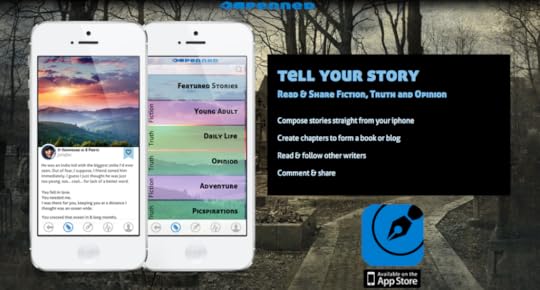Stavros Halvatzis's Blog, page 50
September 21, 2014
Observe, Understand, Write.

Hey, that's my spot!
People, in the main, are full of foibles, idiosyncrasies, kinks. We like to do things in a certain way, especially the small things: trace a particular path to work from the parking lot, place our shampoo bottle just-so on the basin, put on the right shoe first, rather than the left. We create little rituals, which, ostensibly, grant us comfort, provide us with some semblance of meaning, and, perhaps, even point us to some deeper truth.Studies by psychologists, neurologists, and a myriad of other squabbling specialists offer us explanations that range from outright pathology, to the physical deepening of neuron pathways in our brains.
As a writer of novels, I am, of course, interested in the various in-depth explanations of ritual and habit. I routinely read papers on neuroscience, psychology, quantum physics, and the social ‘sciences’. But the truth is that I am far more concerned with describing emotional motivation as a function of drama in a story.
I remind myself that the best stories are not simply about philosophy, psychology, social justice, although, they do check those boxes. The best stories endure because they offer us good drama. They engage our emotions. If they do get us to wrestle with the underlying concepts at all, they do so because they first get us to feel something about the people — colourful, authentic characters brimming over with kinks, foibles, and rituals.
Every Friday morning, I like to eat hotcakes with butter and syrup at McDonalds before my first lecture on documentary filmmaking at a college in downtown Johannesburg. I’m usually the first customer to be served when the doors open at 6am – I leave home early to avoid bumper-to-bumper traffic later.
But sometimes I am pipped to the post by an even earlier bird – the same one each time.
Not much of a problem in the grand scheme of things. There are, after all, more than enough hotcakes to go around. Besides, the bun-patty-egg meals are far more popular.
But then, there is the small matter of my favourite spot.
The table, tucked away in the far corner, is flanked on two sides by large windows that look out into the parking lot and the trees that surround it. I really like that spot. I like it almost as much as I like my hotcakes. I am convinced that they taste better eaten there.
The trouble is, so does the earlier bird.
Now, good manners would have me yield my spot to her, even if, for some reason, I clear the counter with my tray before she does.
And I do. Usually.
But pettily enough, I secretly wish I got there just a minute earlier. I find myself scanning the interior of the shop for my spot even as I’m pulling into the parking area. That long walk to the front entrance feels like a race to the finish line. It informs my behavior for the next minute or two.
Thinking about it now, I can’t help shaking my head in embarrassment.
Yet, despite this, I believe such foibles, habits, and inclinations, trivial as they are, help make us who we are – either because they speak of more a serious condition that needs identifying, or because they offer us a chance to rid ourselves of pettiness as we struggle to learn and grow from life’s lessons.
And speaking of lessons, there is that character in my next novel with a penchant for early-morning Macdonalds hotcakes and corner tables that has just decided to try out a different spot-and-meal combination, and to do so graciously…
Summary
Studying eccentric behaviour that we and others engage in on a daily basis helps us write captivating, fictional characters that bristle with life, authenticity, and colour.
Invitation
If you enjoyed this post, kindly share it with others. If you have a suggestion for a future one, please leave a comment and let’s get chatting. You may subscribe to this blog by clicking on the “subscribe” or “profile” link on the bottom right-hand side of this article. I post new material every Monday.
Image: Kendrickmartin
License: https://creativecommons.org/licenses/...
September 14, 2014
How to Spark your Info Scenes

Sparking your Scene:
How many times have we come across this scenario? Our hero needs to uncover information about someone, or something. She googles, goes to her local library, zips through old newspapers, records…Yawn.
In his book, Your Screenplay Sucks, William M. Akers suggests the only memorable thing about such a scene would be if the computer blew up in her face, or a library shelf collapsed and hit her on the head.
Staring at computer screens, or paging through records makes for static scenes. It is much better to have your character corner a grumpy librarian and try to solicit the information from her, or try to bribe a shady cop, or talk to the local priest. Now, you not only get the information necessary to drive your story forward, but you layer the scene with tension or humor via the subtext rooted in the reluctant informant. The result is a richer, more dramatic and entertaining event. Even if your character fails to extract the information, she generates added interest.
In Chinatown, Jack Nicholson has to deal with a sour, officious clerk. He asks if he can check out a book of records from the facility and is told this is not a lending library. He then asks the clerk for a ruler. “A ruler?” the man snarks back. It’s to help keep his eyes focused on the lines of text, Nicholson replies. The clerk slaps a ruler on the desk in front of him. Nicholson grabs it and hurries back to the records book. He coughs loudly, simultaneously tearing a page from the book with the aid of the ruler.
Good writing!
Not only does the hero get the information he needs, he makes a fool of the unlikable clerk. The scene works on two levels — plot and drama.
Interaction between characters is always superior to mere eyeballing of screens, or flipping through pages in a book. Scour your story for scenes which only serve the plot and try to inject human conflict into them, even if that conflict is small, as in the above example. Your scenes will be better for it.
Summary
Information gathering in a scene can become boring if not handled right. Extracting information from another character is superior to extracting it from the internet or a book. At the very least, have your hero try to convince others to help him acquire it.
Invitation
If you enjoyed this post, kindly share it with others. If you have a suggestion for a future one, please leave a comment and let’s get chatting. You may subscribe to this blog by clicking on the “subscribe” or “profile” link on the bottom right-hand side of this article. I post new material every Monday.
Image: Sadi Santos Photography
License: https://creativecommons.org/licenses/...
How to Add Spark to Info Scenes

Sparking your Scene:
How many times have we come across this scenario? Our hero needs to uncover information about someone, or something. She googles, goes to her local library, zips through old newspapers, records…Yawn.
In his book, Your Screenplay Sucks, William M. Akers suggests the only memorable thing about such a scene would be if the computer blew up in her face, or a library shelf collapsed and hit her on the head.
Staring at computer screens, or paging through records makes for static scenes. It is much better to have your character corner a grumpy librarian and try to solicit the information from her, or try to bribe a shady cop, or talk to the local priest. Now, you not only get the information necessary to drive your story forward, but you layer the scene with tension or humor via the subtext rooted in the reluctant informant. The result is a richer, more dramatic and entertaining event. Even if your character fails to extract the information, she generates added interest.
In Chinatown, Jack Nicholson has to deal with a sour, officious clerk. He asks if he can check out a book of records from the facility and is told this is not a lending library. He then asks the clerk for a ruler. “A ruler?” the man snarks back. It’s to help keep his eyes focused on the lines of text, he replies. The clerk slaps a ruler on the desk in front of him. Nicholson grabs it and hurries back to the records book. He coughs loudly, simultaneously tearing a page from the book with the aid of the ruler.
Good writing!
Not only does the hero get the information he needs, he makes a fool of the unlikable clerk. The scene works on two levels — plot and drama.
Interaction between characters is always superior to mere eyeballing of screens, or flipping through pages in a book. Scour your story for scenes which only serve the plot and try to inject human conflict into them, even if that conflict is small, as in the above example. Your scenes will be better for it.
Summary
Information gathering in a scene can become boring if not handled right. Extracting information from another character is superior to extracting it from the internet or a book. At the very least, have your hero try to convince others to help him acquire it.
Invitation
If you enjoyed this post, kindly share it with others. If you have a suggestion for a future one, please leave a comment and let’s get chatting. You may subscribe to this blog by clicking on the “subscribe” or “profile” link on the bottom right-hand side of this article. I post new material every Monday.
Image: Sadi Santos Photography
License: https://creativecommons.org/licenses/...
September 7, 2014
Penned: Tell Your Story
Penned:
AN INDIE writer’s path to success is difficult one. The journey not only demands writing excellence, but marketing acumen as well. In this post I want to highlight a free and useful utility for indie writers working on iPhones and iPads that may make the marketing part of the journey a little easier. I have it on good authority the app is about to be released on android, too. Its name is Penned .Penned allows you to create a profile and upload sample chapter(s) of your book in a genre of your choosing. I found the interface to be intuitive and easy to use, although it did crash a couple of times on my iPad.
The app allowed me to upload chapters from three of my novels: Scarab, Scarab II, and The Level for display. Like Wattpad, the programme links writers with readers and other writers, encouraging comments and debate on the work presented. Anyone liking what they read on Penned can go to Amazon, Barnes and Noble, or wherever their work is sold, and buy a copy there. I’ve received several comments already, and have even seen a slight bump up in sales on my Amazon page, which, for an indie writer, is all to the good.
Of course, there are many other forums for this sort of discussion, exhibition, and discovery of work to occur, but what is especially cool for an indie writer about a relatively new app is the terrain has not yet become crowded. Needless to say the situation may change as the programme gains exposure and popularity.
Any effort to increase the number of places where indie writers can discover, exhibit, and discuss work has to get a thumbs-up, and Penned certainly gets mine.
Why don’t you give it a try? The space provided by this app may be just the place where you make your next big breakthrough!
Summary
Penned is a great free app for writers and readers that allows you to upload and share sample chapters of your work. It’s a great new way to discover new talent, as well as to introduce yourself to others.
August 31, 2014
Excitement vs Tension in Stories

Choise = Tension
Do you want to keep your readers or audience glued to your story? Try this: In his book, Your Screenplay Sucks, William M. Akers urges us to keep ramping up the tension of our tales. The tension he is referring to here is different from shoot-outs and car chases – that’s chiefly excitement through action, not tension.True tension is coiled up inside agonising moral choices: Which one of her two children does a mother sacrifice to save the other — Sophie’s Choice. Does the father in Mast lower the drawbridge to prevent the train from falling into the river, or does he leave it up and avoid crushing his son who has fallen into the lifting mechanism of the bridge?
Not all choices have to be world changing. They can be ostensibly small, as long as they are significant for the characters who make them. In Remains of the Day, Anthony Hopkins keeps the inquisitive Emma Thompson from seeing the title of the book he is reading. It’s a small action in the scene, but the tension in her wanting to know is palpable.
Higher stakes need higher sacrifices to resolve them. Whether the stakes are world domination as in a James Bond movie, or merely the control of your home, they are still high for the affected characters. If your characters don’t have everything to lose, ratchet up the stakes and keep doing so as the story progresses to keep the tension high.
In A Few Good Men, Tom Cruise is trying a big case which will send his client to prison for a long time, if he loses. But later in the story, the stakes rise even more. If Cruise gambles on turning the tables on the Jack Nicholson character, and fails, not only will he lose the case, it will cost him his Navy legal career. For a man living in the shadow of his father, the previous U.S. Attorney General, the stakes are high indeed.
In peppering your story with tension, ask yourself the following questions: What are the stakes for my hero and how can I raise them? What is the moral choice she faces, and what does she stand to lose if she makes the wrong one? Correctly structuring the tension in your story will make for a more gripping tale.
Summary
Keep your hero on the tension tightrope by confronting her with difficult moral choices.
Invitation
If you enjoyed this post, kindly share it with others. If you have a suggestion for a future one, please leave a comment and let’s get chatting. You may subscribe to this blog by clicking on the “subscribe” or “profile” link on the bottom right-hand side of this article. I post new material every Monday.
Image: Dan Moyle
License: https://creativecommons.org/licenses/...
August 24, 2014
How to Save the Cat in your Story

Save the Cat, Save the Day:
Blake Snyder’s (Save the Cat) beat-sheet of 15 dramatic units that define the entire story offers perhaps the most potent and clear advise on structuring your tale. So, far be it for me to try and modify it. I do, however, want to expand upon Mr. Snyder’s 13th and 14th beats, The Dark night of the Soul, and Finale, since I believe they may allow for a possible weakness in the verisimilitude of the story, if not properly used.These beats follow in the wake of several others, immediately before, which show the hero at his lowest ebb. They concern the moment when, despite the hero being down and out, both physically and spiritually, his goal in tatters, he finds the strength to try again. It is the most vulnerable point of Hollywood’s ‘up endings’ — the moment when the story, which cannot allow the protagonist to fail, ushers in an event that turns the tables on the antagonist.
How do we prevent this event, this new twist, from appearing trite and forced? How do we avoid our beats being labeled ‘a typically predictable Hollywood moment?’
We concentrate on making the intersection between the visible outer journey event, and the hero’s inner journey—his backstory, the theme, and his character traits—the best and strongest it can be.
What possible justification can we offer the audience or reader to convince them that the hero can find the inner strength to try again, at this late hour? It can’t be opportunistic—an out-of-left-field event would reek of the very triteness we seek to avoid. It has to tie into the spiritual and moral strength the hero garners through pain and suffering in the outer journey. It has to tie into the theme of the story.
In Gladiator, Maximus finds himself on his knees in the arena, poisoned, swordless, and pierced by the Emperor’s blade. His efforts to avenge his murdered family and save Rome from the clutches of the madman seem ended. But his love of family and his loyalty to Rome are enough for him to find the strength to pull the Emperor’s sword from his own body, and turn it against the Emperor himself, ending the tyrant’s life.
The solution to the initially hopeless situation is deeply routed in Maximus’ moral strength and his realisation that there will be no further opportunity than this to end the tyrant’s life, ironically enough, by his own sword. It integrates the theme of the story — integrity and moral fortitude trump lascivious greed — with one last heroic act. It avoids the accusation of a forced and predictable ending. It feels right because we find it fitting that a man as righteous and noble as Maximus, who has given his life to the service of Rome, should rid it of its incestuous ruler by sacrificing his own life. It is a fine example of how the inner journey motivates and explains the outer journey, especially at the critical last points of the Blake Snyder’s beat-sheet.
Summary
Tying crucial physical events to the hero’s inner journey helps us to experience them as fitting, rather than as forced and predictable.
Invitation
If you enjoyed this post, kindly share it with others. If you have a suggestion for a future one, please leave a comment and let’s get chatting. You may subscribe to this blog by clicking on the “subscribe” or “profile” link on the bottom right-hand side of this article. I post new material every Monday.
Image: Moyan Brenn
License: https://creativecommons.org/licenses/...
August 17, 2014
Why the Outer and Inner Stories Must Cross

Crossing Code:
In his book, Save the Cat, Blake Snyder offers us this piece of invaluable advice: “Keep in mind the only reason for storytelling and why [story] A [outer] and [story] B [inner] must cross throughout: It’s to show the true reason for the journey is not getting the tangible goal, but learning the spiritual lesson that can only be found through the B Story!”This is what the tale is really about: learning the spiritual lesson that allows the hero to overcome the obstacles life and the antagonist throw his way.
At the inciting incident, the hero is given a wake-up call. A ripple runs through his ordinary world. His first response is usually incorrect. In Edge of Tomorrow, Tom Cruise is told he is to go to the war-front to film the allied invasion. His response is to try and blackmail the General in order to force him to reverse his decision. Not a good call.
The first turning point represents the true start of the story. It also sets the outer goal. Tom Cruise is killed, but gets covered by the blue blood of the Alpha Mimic, which causes him to return to relive the day. His response upon finding himself back at square one, however, is to try and talk the Master Sergeant into letting him call his superiors. Lesson still not learnt.
By the midpoint, Cruise finally realises why he keeps returning to the same event, over and over again. He has to team up with the Angel of Verdun and defeat the Mimics by killing their leader, the Omega. Our reluctant protagonist has gone from unwilling participant to motivated Hero. Here, the outer and inner journeys fuse into a single and clear purpose—a plan to save the world from the invading Mimics—even if it means sacrificing oneself to do it. Over and over again.
By the second and final turning point, his recurring efforts are in danger of stalling—a blood transfusion will rob him of his ability to return and relive the day, just as it did the Angel of Verdun’s. And while he is at first reluctant to sacrifice her to this possible permanent-death scenario, he realises that he has no choice but to risk it, if he is to have any hope of defeating the Mimics. This represents a step up in spiritual growth and is a perfect illustration of the two journeys intersecting once more.
The inciting incident, the first turning point, the midpoint, and the second turning point, then, present the writer with perfect opportunities for interweaving the inner and outer journeys of the story. They weld the Hero’s transformational arc to his pursuit of the outer goal.
Summary
The inner journey, or the B Story is the spiritual transformational arc the hero undertakes in order to acquire the true goal.
Invitation
If you enjoyed this post, kindly share it with others. If you have a suggestion for a future one, please leave a comment and let’s get chatting. You may subscribe to this blog by clicking on the “subscribe” or “profile” link on the bottom right-hand side of this article. I post new material every Monday.
Image: Keith Ramsey
License: https://creativecommons.org/licenses/...
August 10, 2014
Why the Hero Needs his Nemesis

Force for Growth
One of the chief functions of the antagonist is to force the protagonist to evolve. Without the constant prodding that causes the hero to recognise the way to overcome his nemesis is through personal growth and inner strength, his actions and decisions to achieve the goal remain on an even keel, and are, ultimately, doomed to failure.Die Hard‘s John McClane is in a bad marriage. He is separated from his wife and is headed for divorce before Hans Gruber enters the fray, kidnaps a bunch of people, including John’s wife, and forces him to step up to the mark. By having to rescue his wife from the arch criminal’s clutches, John realises how much he truly loves her and what he has to do to save his marriage, which he does. Thank you, Hans Gruber.
In The Matrix, Neo is riddled with self-doubt. Is he indeed The One? The answer remains unclear until he faces and defeats agent Smith in one rollicking fight to the finish. But for agent Smith, Neo might still be vacillating over this world-changing question.
At the beginning of Casablanca, Rick Blaine is self-serving and unlikable, until he gives up on the woman he loves in order to contribute to the war effort. This is a huge shift for him. Were it not for Ilsa Lund, the opponent who turns his world upside down, he would not have grown through this sacrifice, remaining static and selfish — someone of no moral consequence.
In Crash, Terrance Howard has to deal with a series of problems concerning his wife, as well as with the specter of racism. But having to respond to and overcome Matt Dillon’s constant harassment, he emerges a stronger and better man. Here again, no Matt Dillon, no personal growth.
Although the clash between the protagonist and antagonist ostensibly occurs at the surface level, the level of actions and events, it is the effect on the Hero’s inner landscape that marks its true significance.
Summary
The antagonist is the protagonist’s polar opposite. He forces the protagonist to change for the better.
Invitation
If you enjoyed this post, kindly share it with others. If you have a suggestion for a future one, please leave a comment and let’s get chatting. You may subscribe to this blog by clicking on the “subscribe” or “profile” link on the bottom right-hand side of this article. I post new material every Monday.
Image: Kris Krug
License: https://creativecommons.org/licenses/...
August 3, 2014
How to Structure your Reveals

Revealing Secrets:
When and how do you reveal that big secret in your story? All at once? Through smaller increments and surprises? The latter encourages your reader to follow the bread crumbs with heightened interest.In his chapter on structure William Akers stresses the importance of placing your reveals at the right place. He uses an example provided by UCLA’s screenwriting programme head, William Froug, about an old man feeding pigeons from a park bench. Does he dump the whole bag of crumbs on the grass right away, or does he scatter a few at a time to keep the feeding dispersed and the pigeons interested longer?
Clearly the second option is the better one.
The book upon which the film Notes From a Scandal is based starts with a big scene in which it is revealed that the Cate Blanchett character has had an affair with one of her students. The book handles this information as the inciting incident. It’s a heck of a start for the story, but it does give away the biggest secret right away. The film version handles this differently, revealing the news a little later. It keeps the audience on a string and loads up the reveal with more punch.
In Butch Cassidy and the Sundance Kid, screenwriter William Goldman saves the small surprise that Butch is from New Jersey for when the movie is well under way, and only offers an even bigger reveal a little later when the men are about to hit the payroll guards in Bolivia. During the face-off with a bunch of rough-looking bandits, Butch tells Sundance that he’s never shot anyone in his life before. It’s not a good time to let your partner-in-crime know of your lack of experience. It is a hugely impactful moment for the audience.
Imagine, if you will, if Goldman had started the story by having Butch introduce himself to Sundance with,”Hi there. My name’s Robert Leroy Parker. I’m really from New Jersey. I’ve never shot anyone in my life before!”
Pretty lame.
Summary
Withholding crucial information for as long as possible, and releasing it at dramatically heightened moments, makes for keener audience interest and improves the quality of your story.
Invitation
If you enjoyed this post, kindly share it with others. If you have a suggestion for a future one, please leave a comment and let’s get chatting. You may subscribe to this blog by clicking on the “subscribe” or “profile” link on the bottom right-hand side of this article. I post new material every Monday.
Image: Lisa M Photography
License: https://creativecommons.org/licenses/...
July 27, 2014
How to Nail your Amazon Logline

Nailing Your Logline:
So, you’ve written your literary masterpiece and posted it up on Amazon with a book cover and description, which, in your opinion, is darned perfect.But if your book is so great and your description so spot-on, why isn’t anyone buying it? You’ve promoted it, so you know readers know its there, but where are the sales?
There is a good chance that your logline – that short description at the top of your Amazon product page meant to set up your story in an intriguing and succinct way intended to persuade readers to buy your book by – falls short. It may even suck altogether.
In a logline containing a couple dozen or so words, each word weighs a ton. There is a limit to how much tonnage you can load up on the scale. You’ve got to ensure that each word is there because it makes an invaluable contribution to the overall sentence. Superfluous and ill-chosen words make for superfluous and ill-chosen loglines. If a word doesn’t contribute to tone or meaning, strike it from the sentence.
Brevity and precision aside, ask yourself whether your logline paints a picture of what your story is about and poses an intriguing question the reader is dying to have answered. If your logline falls to hook the reader immediately she will drift over to another page in search of something better to read.
But there is another crucial thing a logline must do. It must play fair with the reader. Your book cover and logline are the promise you make your readers: Buy my book and you’ll get the sort of story I describe. Fail to do so, or change the genre halfway through the book, and you may disappoint or even anger them, with devastating results when they come to reviewing your book.
Don’t get me wrong. I love surprises. I hate predictability. I love to cook with morsels from different genres in order to create new and surprising flavours. But if you promise your readers a drama, don’t give them a satire. They’ll punish you for it.
Upon first publishing my new scifi/technothriller, The Level, on Amazon, I offered the following description:
A man, suffering from amnesia wakes up in a pitch-black room, tied to what feels like a wooden chair. He discovers he is a prisoner in an abandoned, labyrinthine asylum hunted by shadowy figures out to kill him. An enchanting woman dressed in a black burka appears out of the darkness and offers to show him the way out, if only he can remember who he truly is. But the truth is more terrifying than anything anyone could have ever imagined.
The book did well, jumping to number 22 on the Amazon top 100 Bestseller list in its category. But a chat with a fellow writer drew my attention to the possibility that my description was missing a vital ingredient: the scifi/technothriller element. In fact, as it stood, the cover and logline screamed: Horror genre! And while there are strong thriller/horror elements in the story, I realised I wasn’t playing fair with my readers.
So, I reworked my logline and came up with the following:
A man with no memory hunted down the twisted corridors of a derelict asylum by murderous figures…
A computer programmer desperate to eliminate a flaw in her code before the software is released to an unsuspecting public…
Two lives bound together by a terrifying secret.
This logline has the elements of the previous one, but adds technology to the broth — a huge part of the story. It plays fair with the reader.
Will it do better at selling the book than the previous logline? Only time and the numbers will tell. In the meantime, perhaps you could write in and tell me your preference.
Summary
Using precise, economic language, posing an intriguing question, and playing fair with the reader in terms of genre are some of the most important elements in crafting an effective logline.
Invitation
If you enjoyed this post, kindly share it with others. If you have a suggestion for a future one, please leave a comment and let’s get chatting. You may subscribe to this blog by clicking on the “subscribe” or “profile” link on the bottom right-hand side of this article. I post new material every Monday.
Image: kodomut
License: https://creativecommons.org/licenses/...




